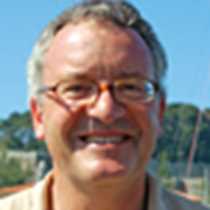Lisbon, Portugal
We sailed up the Tagus river towards Lisbon in the early hours of the morning to pass under Europe’s second largest suspension bridge, the former Salazar Bridge, now named the Bridge of 25 April, in commemoration of Portugal's democratic revolution of 1974 when the dictatorship was overthrown. Now a member state of the thriving European Union, Portugal has a new found prosperity and is shaking off an image as one of Europe's poor relations.
That Portugal should have been synonymous with poverty for so long is a fact of history that demands explanation. For Lisbon was catapulted from provincial obscurity to first power status at the end of the fifteenth century by a visionary leader and a band of intrepid explorer-navigators, celebrated in the exuberant Monument to the Discoverers on the bank of the Tagus. Henry the Navigator, whose bust is at the prow, understood that the fall of Constantinople to the Muslim Turks in the middle of the fifteenth century and the consequent decline of the Venetian carrying trade, was Portugal’s opportunity. He set up a school of navigation at Sagres that drew on the inheritance of Arab learning in the Iberian Peninsula to plan a series of expeditions that nosed along the west coast of Africa. On Christmas Day 1487, Bartholomew Diaz rounded the continent at a Cape he confidently named Good Hope. That hope was fulfilled ten years later when Vasco da Gama reached Calicut on the Indian sub-continent in 1497. By 1500, Cabral, running with the trade winds on the same Atlantic routes inadvertently discovered Brazil. The Portuguese Empire had been born. The spices of the orient were now being brought back to Lisbon directly by sea at rock bottom prices.
The exotic world of the tropics captivated and inspired Portugal’s artists and writers. The national poet Camoes lies with Vasco da Gama in a place of honor inside the Jeronimoes monastery, itself a remarkable survival of the Manuelline style after the 1755 earthquake that destroyed so much of the mediaeval city. Its pillars and arcades are carved with tropical foliage and elephants support the altars; rope-work, globes and the cross of Templars are the three dominant motifs. Following our tour of the monastery we visited the Belem Tower (photographed) that symbolically guards the inner harbor of the city. Here, the wealth of sea borne empire arrived on the quayside of the Portuguese capital but the spirit of open enquiry that had given birth to the Age of Discovery was eclipsed within a generation by the intolerance of a triumphalist Catholicism with its Inquisition. Jewish merchants and traders, whose talents had been as essential to the Portuguese project of exploration and adventure as was the learning of the Muslim world, were now expelled from Portugal just as the Moors had been some generations previously. The result of intolerance was a paradoxical poverty that lasted into modern times.
We sailed up the Tagus river towards Lisbon in the early hours of the morning to pass under Europe’s second largest suspension bridge, the former Salazar Bridge, now named the Bridge of 25 April, in commemoration of Portugal's democratic revolution of 1974 when the dictatorship was overthrown. Now a member state of the thriving European Union, Portugal has a new found prosperity and is shaking off an image as one of Europe's poor relations.
That Portugal should have been synonymous with poverty for so long is a fact of history that demands explanation. For Lisbon was catapulted from provincial obscurity to first power status at the end of the fifteenth century by a visionary leader and a band of intrepid explorer-navigators, celebrated in the exuberant Monument to the Discoverers on the bank of the Tagus. Henry the Navigator, whose bust is at the prow, understood that the fall of Constantinople to the Muslim Turks in the middle of the fifteenth century and the consequent decline of the Venetian carrying trade, was Portugal’s opportunity. He set up a school of navigation at Sagres that drew on the inheritance of Arab learning in the Iberian Peninsula to plan a series of expeditions that nosed along the west coast of Africa. On Christmas Day 1487, Bartholomew Diaz rounded the continent at a Cape he confidently named Good Hope. That hope was fulfilled ten years later when Vasco da Gama reached Calicut on the Indian sub-continent in 1497. By 1500, Cabral, running with the trade winds on the same Atlantic routes inadvertently discovered Brazil. The Portuguese Empire had been born. The spices of the orient were now being brought back to Lisbon directly by sea at rock bottom prices.
The exotic world of the tropics captivated and inspired Portugal’s artists and writers. The national poet Camoes lies with Vasco da Gama in a place of honor inside the Jeronimoes monastery, itself a remarkable survival of the Manuelline style after the 1755 earthquake that destroyed so much of the mediaeval city. Its pillars and arcades are carved with tropical foliage and elephants support the altars; rope-work, globes and the cross of Templars are the three dominant motifs. Following our tour of the monastery we visited the Belem Tower (photographed) that symbolically guards the inner harbor of the city. Here, the wealth of sea borne empire arrived on the quayside of the Portuguese capital but the spirit of open enquiry that had given birth to the Age of Discovery was eclipsed within a generation by the intolerance of a triumphalist Catholicism with its Inquisition. Jewish merchants and traders, whose talents had been as essential to the Portuguese project of exploration and adventure as was the learning of the Muslim world, were now expelled from Portugal just as the Moors had been some generations previously. The result of intolerance was a paradoxical poverty that lasted into modern times.




